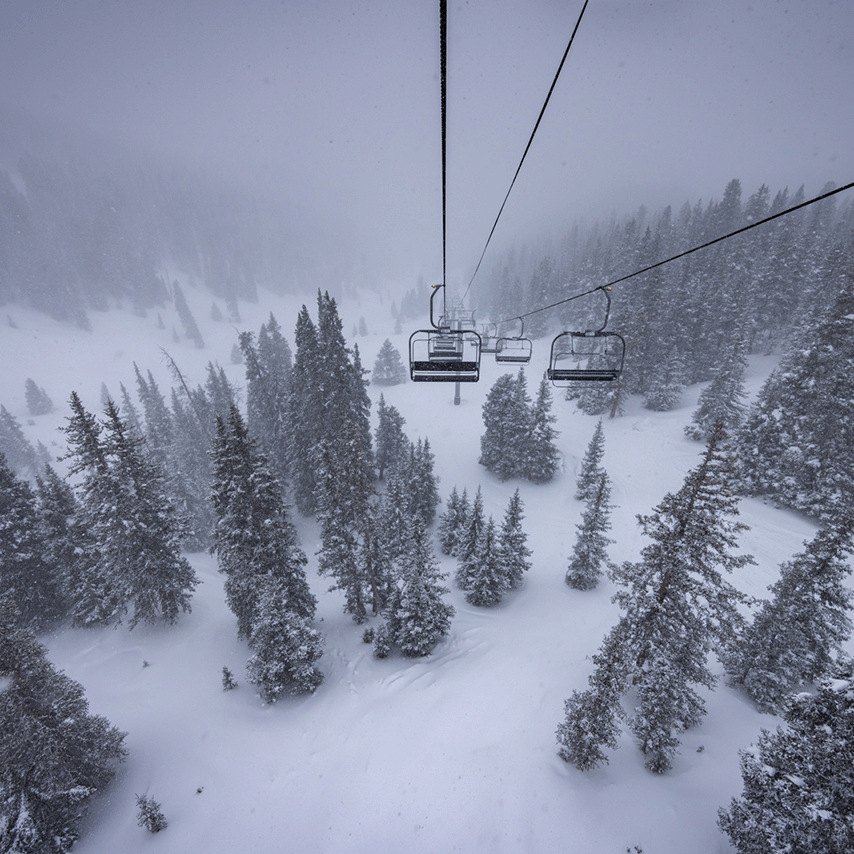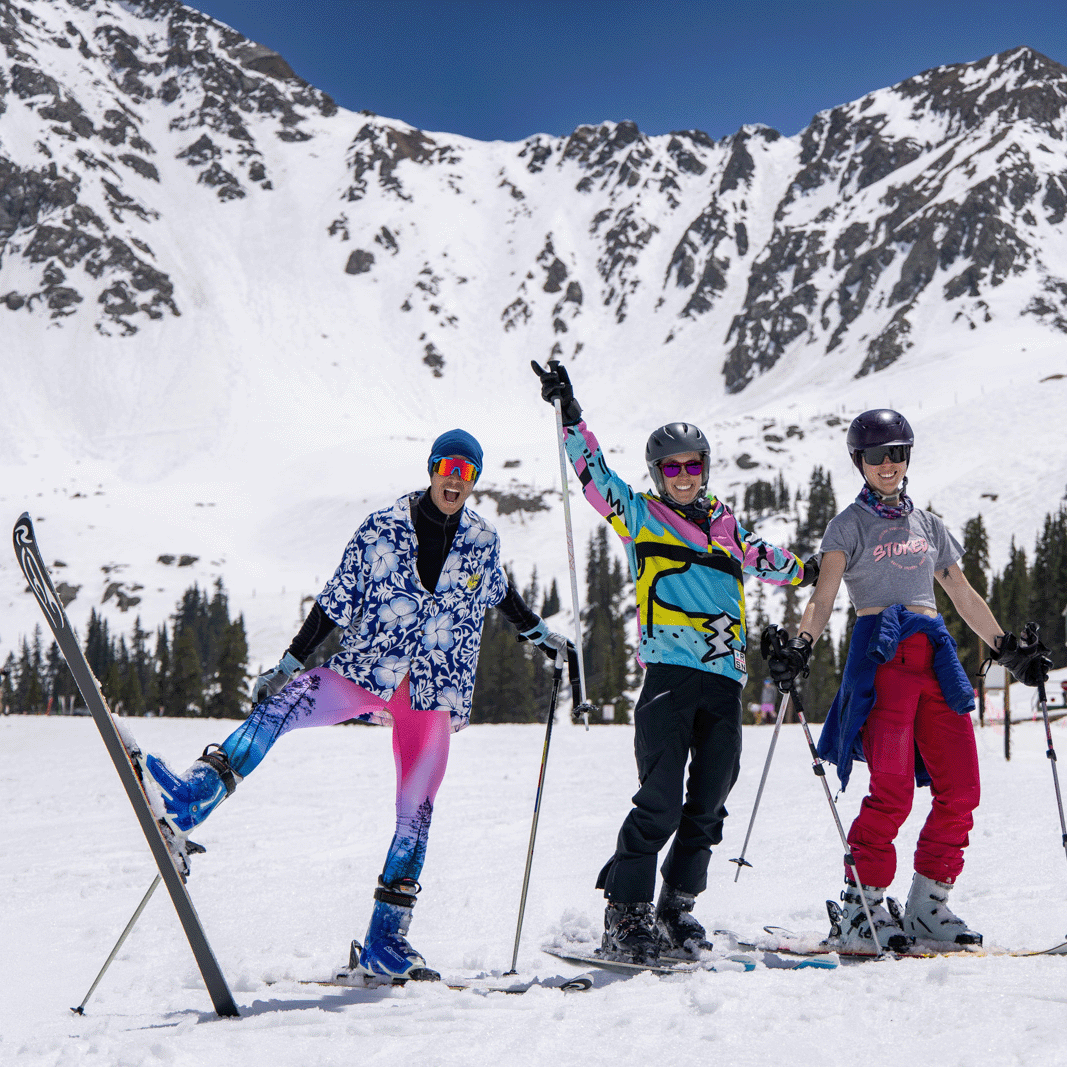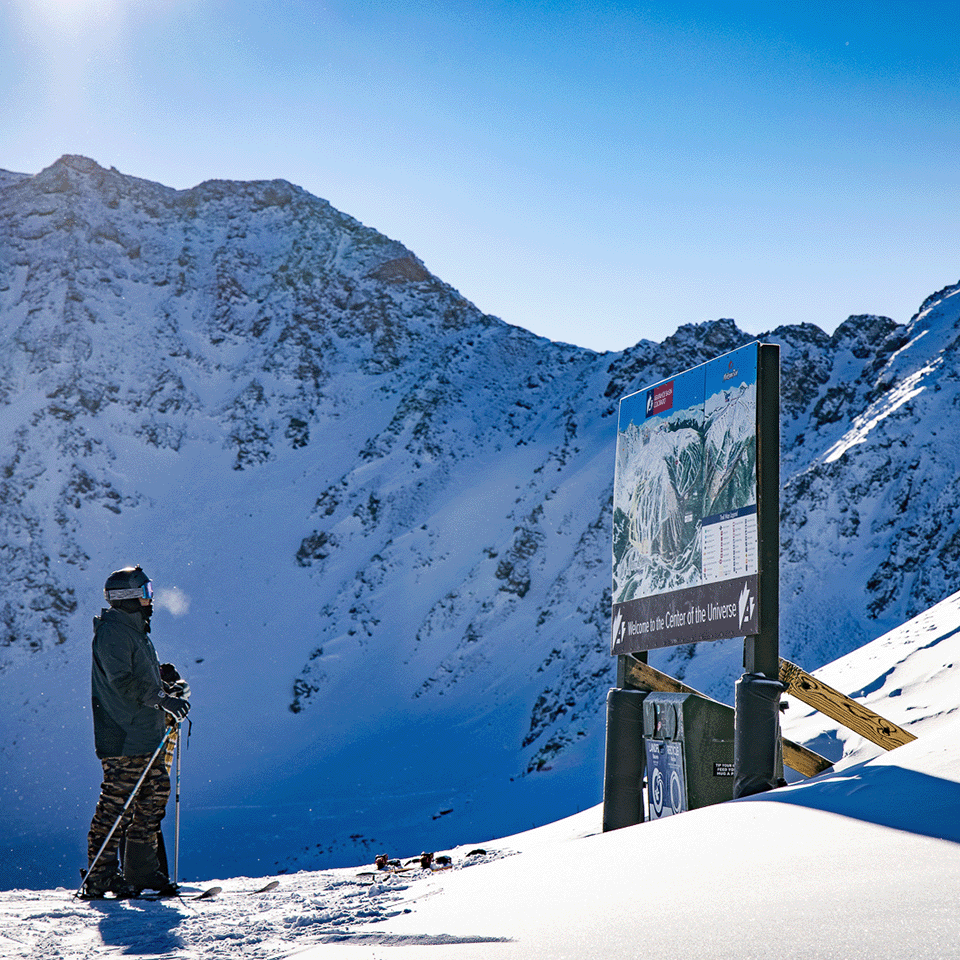
Today, Arapahoe Basin Ski Area announced it is now operating on a net-zero carbon footprint. After setting a goal to reach Carbon Neutrality by 2025 in 2018, the ski area achieved this massive feat months ahead of schedule, following the announcement of 100% renewable electricity in late 2023.
“A-Basin is committed to being stewards of the White River National Forest so that current and future generations can continue to enjoy it in every season for years to come,” said Alan Henceroth, COO of Arapahoe Basin Ski Area. “We are so proud of this accomplishment and are looking towards our next set of sustainability goals for 2025 and beyond to continue being leaders in the industry.”
In 2018, Arapahoe Basin created a six-step plan to reach carbon neutrality. These steps included working towards 75% waste diversion, improved transportation efficiency, responsible procurement, no net increase in domestic water use, and continuing to lead in ecosystem stewardship and wildlife management. A major milestone was converting all electricity use at the ski area to 100% renewable sources, completed in October 2023. Since then, buildings, electric vehicle charging stations, lifts, snowmaking activities, and other ski area needs have run on clean electricity.
The final step to reaching net zero was to continually reduce Scope 1 direct greenhouse gas emissions and, on the way to eliminating these emissions completely, offset them through tangible carbon reduction projects. To do so, Arapahoe Basin partnered with Terrapass to create a portfolio of U.S.-based, third-party verified carbon offsets.
“Achieving carbon neutrality thanks to this partnership with Terrapass is great for us, but definitely not the end of our climate action journey,” said Mike Nathan, Sustainability Manager at Arapahoe Basin Ski Area. “After getting to 100% renewable electricity last year, and with viable carbon-free systems nearly within our grasp, we now know for sure that our real goal - Net Zero, Carbon-Free Operations - is just over the horizon. These offsets simply allow us to do some good in the meantime, while the cost of supporting these projects every year financially motivates us to finish the job.”
Carbon offsets are credits individuals, corporations, or groups can use to compensate for their own emissions of CO2 into the atmosphere. Each credit is used to offset one metric ton of CO2 emitted and represents one metric ton of CO2 removed or avoided from the atmosphere from the project source. When employed properly, they serve as a “self-imposed tax” for all emitted carbon and can help incentivize emissions reductions as cost-saving measures.
Over the course of the 2022-23 season, Arapahoe Basin emitted 900 metric tons of CO2 through diesel, propane, and gasoline usage and an additional 50 metric tons through solid waste disposal. The ski area used this number to predict 2023-24 emissions and has preemptively offset 950 metric tons of carbon. A-Basin will reconcile those offsets against actual emissions when 23-24 data is complete, banking extra offsets or purchasing more accordingly.
Arapahoe Basin’s sustainability program goes beyond a roadmap for ski area operations and has evolved into a culture. The ski area has large-scale projects like on-site solar arrays, restored wetlands, comprehensive revegetation efforts, advocacy and policy work, and area-wide waste reduction efforts, as well as unique, innovative, and one-off projects in remote corners of the resort—all aligned around the shared cause of reducing A-Basin’s emissions and educating guests and staff alike.
Please visit us online to learn more about Arapahoe Basin’s sustainability efforts. An exhaustive list of projects and policies can be found here. Read more about carbon offset quality assurance standards and details of each offset A-Basin support below.
LOOKING TOWARDS THE FUTURE
We’ve reached our goal, but that does not mean we are at our final destination. A-Basin still emits carbon through gasoline, diesel, propane, and solid waste. Carbon offsets are not the final solution for these emissions sources.
Since the beginning of this journey, we've known that a unique business like ours may not find viable carbon-free options for every aspect of the operation, and there would be pieces missing from our net-zero emissions pie. Today, in April of 2024, we still find this to be true. We do send some waste to the landfill to be buried, still need some propane to heat our remote outposts and other buildings, and still rely on heavy equipment that isn’t quite ready to be electrified as of now.
However, unlike in 2018 when we set this ambitious goal for ourselves, today we find many of the decarbonization tools needed for success are within reach. We’re now in a place where we’re confident carbon offsets are a short-term solution, and real net-zero operations are right around the bend.
Since moving to 100% renewable electricity sourcing and addressing roughly two-thirds of ski area emissions, our next big step is full electrification of our vehicle fleet and buildings. This would reduce fuel usage, eliminating these emissions and the need for off-sets altogether. The technology and systems to do this are out there and making their way towards A-Basin as we speak. Electric snowcats are now being deployed at ski areas, and efficient electrical heating technologies are becoming more viable in cold climates every day, to name a few. Other actions to help get there include implementing behavioral changes to reduce usage further, such as creating incentive programs for carpooling, improving waste diversion, reducing overall energy and water usage, and more.
Continuing advocacy work by collaborating with other resorts, non-profits, and government agencies will be essential in making systemic changes that will continue to bring these carbon-free systems to our society and way of life. Continuing to care for our mountain and National Forest land by continuing our revegetation and restoration efforts and by starting a native seed collection program will also be necessary to ensure the health and resiliency of our physical environment in the face of continued pressures and change.
In the meantime, we will use Terrapass carbon offsets to fund a variety of carbon removal and avoidance projects around the U.S. These projects have a plethora of co-benefits in outdoor recreation, indigenous peoples, wildlife, and biodiversity spheres while also creating a financial incentive to continue reducing emissions here at A-Basin. Read on to learn more about our partnership with Terrapass and the specific projects we’re now supporting.
GLOSSARY
ABOUT CARBON OFFSET PROJECTS:
Carbon offset projects can be anything that either removes carbon from or avoids adding new carbon to the atmosphere. These are generally divided into removal offsets and avoidance offsets. Common examples include forest protection, landfill gas capture, energy efficiency, renewable energy, and the repurposing of existing greenhouse gasses.
Removal offsets remove carbon from the atmosphere. Removal projects can include increasing a forest’s carbon sequestration capabilities or restoring a wetland that would then be able to sequester carbon better. Investment into carbon removal technologies would also be considered “removal” offsets. These projects tend to be more expensive.
Avoidance offsets avoid further CO2 emissions by protecting existing forests, capturing landfill gas, investing in energy efficiency and renewable energy projects, etc. These projects tend to be less expensive but still fund projects that maintain and perpetuate the health of existing ecosystems.
ABOUT TERRAPASS:
Terrapass is a carbon offset company that started in 2004 with the intent of helping everyday people reduce the environmental impact of their driving, flying, and energy consumption. Terrapass expanded to include corporations, increasing its carbon removal and avoidance project selection. Terrapass is committed to ensuring verifiable and impactful projects in the forestry, landfill gas capture, and renewable energy sectors, both in the avoidance and removal categories.
Terrapass values verification and ensures that its projects adhere to the highest standards. Projects are verified by the Gold Standard, Verra, Climate Action Reserve, and the American Carbon Registry (all independent third parties).
A-Basin chose to partner with Terrapass for carbon offsets because they had the largest selection of U.S.-based projects, allowed us to pick a variety of projects that fit our “vibe” (i.e., supported outdoor recreation for all, preserving biodiversity, and protecting wildlife), and were upfront about their verification standards. Arapahoe Basin required that our offsets be permanent, additional, verifiable, enforceable, and real (PAVER).
CARBON OFFSET PROJECTS A-BASIN SUPPORTS:
100 Mile Wilderness Improved Forest Management Project (50 MtCO2e) *avoidance
The 100-Mile Wilderness Improved Forest Management (IFM) Project reduces logging activity in areas adjacent to the Appalachian Trail to increase natural forest growth, reducing over 25,000 metric tons of C02 annually. This project protects 13,300 acres of forest land that were once heavily logged. Already, there have been signs of success. Atlantic salmon and Canada Lynx have returned due to the healthy forest and chain of lakes and ponds.
These are avoidance offsets, as forest protection stops logging and harvesting, ensuring the maintenance of the forest’s existing carbon sequestration abilities.
The 50 MTCO2e offset from the 100 Mile Wilderness projects accounts for all emissions generated by A-Basin’s solid waste disposal at the Summit County landfill.
Elk Forest IFM Project (100 MtCO2e) *removal
The Elk Forest IFM Project reduces over 19,000 metric tons of C02 by reducing logging & perpetuating forest growth on 14,230 acres of mixed-hardwood forests in southeastern Kentucky. These activities increase the storage of CO2 in the forest and improve recreation access, wildlife habitat, and forest health. It’s called the Elk Forest because the land contains a thriving elk herd and a healthy population of oak, hickory, yellow poplar, and other hardwood tree species.
These are removal offsets, which entail removing emissions from the atmosphere by increasing the storage of CO2 in the Elk Forest.
Columbia River Forestry Project (100 MTCO2e) *avoidance
The Columbia River Forestry Project works with the Chinook, Cowlitz, and Yakama tribes in Washington State to protect 11,000 acres of forest, remove the Kwaneesum Dam, and preserve 7.8 miles of the Klickitat River frontage. By removing the Kwaneesum Dam, 6-10 feet of silt will be removed, which will provide a cleaner drinking water source for the City of Washougal as well as a restored habitat for salmon and steelhead fish. Regarding forest preservation, about 49,000 metric tons of CO2 are sequestered annually due to harvesting limitations. Sustainable harvesting is done in some areas to support local communities and facilitate tree growth for the benefit of nesting birds, while other areas are fully protected. This area is home to pine forests, oak woodlands, basalt cliffs and grasslands, mule deer, black bears, golden eagles, flammulated owls, and mountain goats. 7.8 miles of the Klickita River is also protected, which conserves its identity as one of the strongest wild steelhead runs and one of the only remaining bull trout runs in the lower Columbia River System. Co-benefits of the project include protecting angling, hunting, wildlife watching, birding, and other public recreation activities.
These are avoidance offsets, as protecting the forest reduces logging and harvesting, which limit the forest’s CO2 sequestration capabilities.
Klawock Heenya Improved Forest Management Project (100 MTCO2e) *avoidance
The Klawock Heenya Improved Forest Management Project protects 8,600 acres of forest on Prince of Wales Island in Alaska. Because 1,000 acres of the KH is an old-growth forest home to a plethora of biodiversity and centuries-old trees, the forest has been harvested for firewood, housing materials, and canoe logs for centuries. Between 1980 to 2015, almost all the usable timber was commercially harvested, with only the old-growth forest remaining. However, second-growth forests in protected areas have flourished since then. Continued management and regeneration of this forest is essential to perpetuate biodiversity, recreational uses, and carbon sequestration.
These are avoidance offsets, which entail that emissions are avoided by ensuring that deforestation does not occur so that the forest can continue sequestering carbon. Terrapass has calculated that the KH project offsets about 138,000 metric tons of CO2 annually.
A-Gas V8 ACR773 (300 MTCO2e) *avoidance
The A-Gas V8 Project reduces over 1 million metric tons of GHG emissions annually by recovering, reclaiming, and repurposing used HFCs from refrigeration and air conditioning equipment, preventing their release into the atmosphere. HFCs are significantly more damaging to the climate than an equal amount of CO2. Co-benefits of reclamation and reduction include the displacement of new materials used to create HFCs and the usage of certain HFCs to recharge refrigeration and HVAC equipment. This project is based in Ohio.
These are avoidance offsets, as HFCs are captured before entering the atmosphere.
Greater New Bedford LFG Utilization Project (150 MTCO2e) *avoidance
The Greater New Bedford LFG Utilization Project captures methane from the Crapo Hill Landfill in Dartmouth, Massachusetts. Because the landfill doesn’t fall under the Federal New Source Performance Standards regulation (or any others), landfill gas capture is not enforced. The landfill sits on 69.8 acres and takes in solid waste & construction/demolition debris, which currently take up 30 of those acres and release methane gas, a toxic greenhouse gas. The project collects the methane and CO2 emissions from the landfill to power a gas-to-energy plan producing 3.3 megawatt hours of clean electricity.
These are avoidance offsets, as methane is captured before it enters the atmosphere to power clean energy.
Gaston County Landfill Gas Destruction Project (150 MTCO2e) *avoidance
The Gaston County Landfill Gas Destruction Project (North Carolina) captures and destroys landfill methane, reducing over 100,000 metric tons of GHG emissions annually. The gasses are then used to produce renewable energy that powers about 1,600 homes for an entire year. This project includes major infrastructure developments, including 70 gas extraction wells, collection system infrastructure, blower/flare, gas compression and cleanup, a 6,000-foot gas transmission system, and a power generation facility.
These are avoidance offsets, as methane is captured before it enters the atmosphere to power clean energy.
CARBON OFFSET QUALITY ASSURANCE STANDARDS:
- Permanent: Carbon sequestration projects must ensure that the carbon stays sequestered. For example, a forestry protection project must ensure that the trees won’t eventually be cut down, as that would release the carbon back into the atmosphere and discredit the offsets purchased.
- Additional: Projects must ensure that the GHG reduction would NOT have happened if not for the offset purchase. For example, some renewable energy projects may have been financed even without carbon finance. That project would not be additional and would discredit the offsets purchased, as offsets must ADD projects that would not have otherwise occurred.
- Verifiable: Projects must be measurable, monitored, and validated by an independent third party with no stake in the project. If direct stakeholders monitored the projects, overestimations of carbon reduction or even false outcomes could occur.
- Enforced: Projects need to be tracked by an independent third party to prevent double counting (i.e., multiple firms should not be able to claim the same offset). If not, multiple firms could theoretically claim the same offset, which would not accurately mitigate both firms’ emissions.
- Real: The amount of reduced carbon must come directly from the offset project's activity.
By ensuring that all projects are PAVER, we greatly reduce the chance of purchasing offsets that overestimate the amount of offset carbon.
The purchasing of carbon offsets to claim carbon neutrality can be controversial, as some corporations use them as an easy way out of making systemic changes to reduce carbon emissions. However, when used properly, they hold corporations financially accountable for their carbon emissions through a “self-tax” of sorts.
For example, if a firm emits 1,000 metric tons of CO2, it must buy 1,000 offsets to claim carbon neutrality. If each offset costs $14 (average cost of an offset), they would pay $14,000 for that claim. This additional $14,000 would hopefully incentivize the company to reduce emissions, invest in green technology, drive sustainable behavior changes among employees, etc., to reduce their emissions and, therefore, its costs. This is known as putting a price on carbon and is an incentive to reduce carbon emissions from within while supporting sustainable projects.



